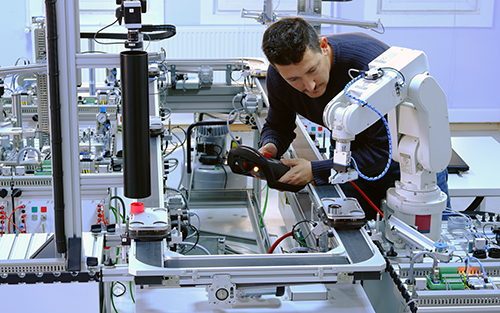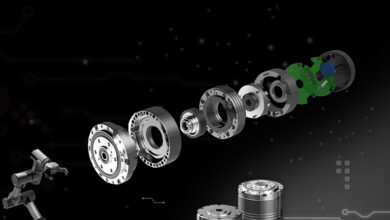Industrial Robots and Their Human Counterparts

Summary
Cobots can reduce worker fatigue, increase production rates and increase quality, all while reducing waste.
The conversation around robots and their use in manufacturing has long been controversial. Many fear that the introduction of robots into the workplace will displace human jobs. In some respects, yes, robots will replace some jobs, but it’s not that simple. Yes, robots will replace some lower-level jobs. These jobs are the more menial and tedious jobs. These are jobs such as quality control on a factory line.
Some of us can recall the opening scene of “Laverne and Shirley” in Shotz Brewery. While their antics are funny and over the top, in today’s manufacturing world, the demands for quality are quite high. The need to ensure those bottles are properly filled and meet customer expectations is more important than ever. With the use of robotics and machine vision, we can now inspect every bottle as it passes at break-neck speed. From ensuring the liquid is filled to the proper level and color accuracy to checking labeling applications and cap being seated correctly, all aspects of the product’s quality are checked and made to meet specific tolerances.
People have off-days and are subject to fatigue, illness and complacency. Robots and machines do not. But the question is: What happens to those employees after their jobs are made obsolete? This is where the employee benefits. Now, those same employees who were being underutilized in the past can move into better quality jobs, including jobs that require problem solving or jobs that require more job fulfillment. These are higher quality jobs. Many of these jobs are in concert with robotics. These are called collaborative robots or cobots for short.
As I said earlier, there is quite a bit of fear about the implementation of cobots in the workplace. Yes, some jobs will be made obsolete. But what many will experience is a shift in their job roles. There will be a need for robot designers, programmers and maintenance workers. Others will need to be upskilled; basically, they will need to get an upgrade in their skillset. This means better pay, better benefits and greater job satisfaction. There are also things that humans are inherently good at, where their robot counterparts are not, such as problem solving skills, critical thinking and creativity.
Cobots have come a long way over the past decade. With safety in mind, these robots work right alongside their human counterparts. These cobots are capable of handling the heavy lifting for humans, allowing them to focus on the more mental workload. For example, at Amazon, cobots are used to move product to pickers rather than the picker going to the shelf, pulling the product and returning to their station. This saves the worker time, steps and possibly a lot of heavy lifting. The cobot saves the worker’s energy and reduces the wear and tear on their bodies daily.
But how do we ensure human safety around cobots? Great question. Today’s safety standards for cobots are exceptionally stringent, as they should be. There are numerous safety features on cobots as defined by ISO/TS 15066, which provides guidelines for the design and implementation of collaborative workspaces. This enables shop managers and manufacturers to safely incorporate cobots into overlapping workspaces between humans and their mechanical counterparts.
Some examples:
1. Maximum allowable speed. This is set at the point of the EOAT (End-of-arm-tooling). These speeds are inline with human equivalent speeds.
2. Speed and separation monitoring. Defines the minimum safety distance between the worker and the robot system to prevent contact between the robot and the human. This can be achieved utilizing safety scanners, light curtains and operator presence mats.
3. Power, force and torque limits. Cobots are designed to measure torque at every joint in case of excessive torques or forces and monitors for sudden impacts, including soft obstructions.
4. Redundant checking systems diagnostics. If the robot detects an anomaly or error at any point, the robot will disable motor power instantly.
5. Safety rated stop modes. Cobots are required to act based on the level of risk. That could be a full emergency stop if a safety mishap has occurred, or it may be a protective stop if a human has entered its operating area.
6. Ergonomic design. In six axis robots, there are a number of potential pinch points. By designing those joints ergonomically, the worker can avoid injury should their hand, fingers, or even loose clothing get trapped in a joint.
With the installation of any robot in a production setting, great care must be taken to ensure a truly safe workspace. This is particularly true in an overlapping workspace that will be shared by humans and their robot counterparts. Consulting a professional installer or integrator will help you to do a full risk assessment and ensure you meet all applicable safety codes and regulations with regards to cobots.
Cobots have the ability to reduce worker fatigue, increase production rates and increase quality, all while reducing waste. In truth, they can be a force multiplier for your production force. In today’s world where we all face labor shortages, increased competition and high consumer demand, cobots can be an equalizer while creating higher quality jobs.
About The Author
Eric Halvorson is marketing technology manager – Automation and Control – at DigiKey.
Did you enjoy this great article?
Check out our free e-newsletters to read more great articles..



